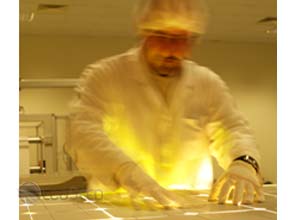Scientists at the Department of Energy’s Lawrence Berkeley National Laboratory are working with semiconducting nanopillars in the hopes of producing the next generation of cheap and scalable solar cells.
High costs tend to be a problem in large-scale applications of solar power generation that use silicon-based solar cells.
However, silicon-based solar cells still have some of the best efficiency rates in the solar subsector. The scientists at Berkeley are looking to improve the efficiency of nanopillar technology for a less costly alternative to traditional silicon.
Nanopillars, densely packed nanoscale arrays of optically active semiconductors, can be crafted with materials less costly than silicon.
One method the Berkeley Lab scientists have been looking into is manipulating the shape and geometry of the nanopillar arrays to enhance their optical absorption properties.
The work is being led by chemist Ali Javey, whose group was the first to demonstrate a technique by which they produced nanopillars from the semiconducting material cadmium sulfide that could be mass-produced in large-scale flexible modules.
The latest development in this work is the production of nanopillars that absorb light as good as or even better than commercial thin-film solar cells, using far less semiconductor material and without the need for antireflective coating.
Dual-diameter structure
The absorption efficiency of the nanopillars was said to have been achieved by the use of a novel dual-diameter structure that featured a small diameter tip, 60 nanometers thick, with minimal reflectance to allow more light in. A large diameter base, measuring 130 nanometers, was also used for maximal absorption.
“This dual-diameter structure absorbed 99 percent of incident visible light, compared with the 85 percent absorption by our earlier nanopillars, which had the same diameter along their entire length,” explained Mr. Javey.
The dual-diameter nanopillars increase the amount of light absorbed while also using less than half the semiconductor material required for thin-film solar cells made from similar material. They also need only about 1 percent of the material used in solar cells made from bulk silicon.
The new nanopillars were fashioned using molds of 2.5 millimeter-thick alumina foil. A two-step anodization process was used to create an array of one micrometer deep pores in the mold. Gold particles were then deposited into the pores to catalyze the growth of the semiconductor nanopillars.
The process allowed the researchers to establish good control over the geometry and shape of the nanopillar arrays. According to Mr. Javey, this fabrication technique is highly generic and could conceivably be used with numerous other semiconductor materials.
The research was partially funded through the National Science Foundation’s Center of Integrated Nanomechanical Systems and through Berkeley Lab LDRD funds.













